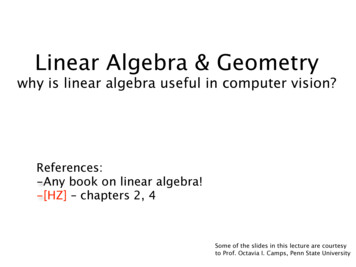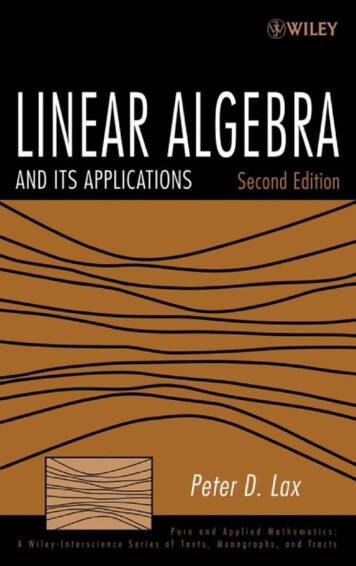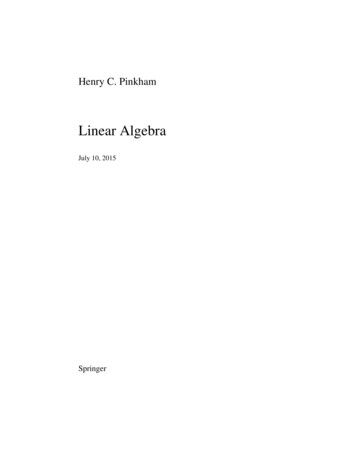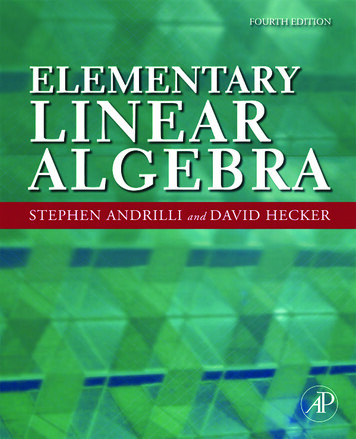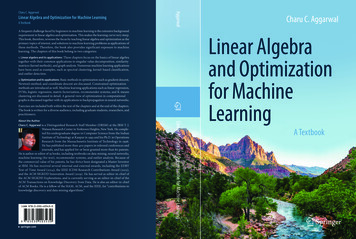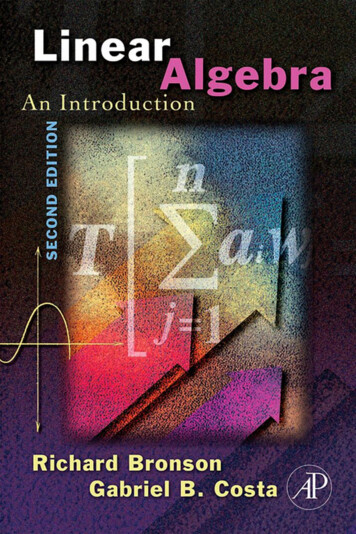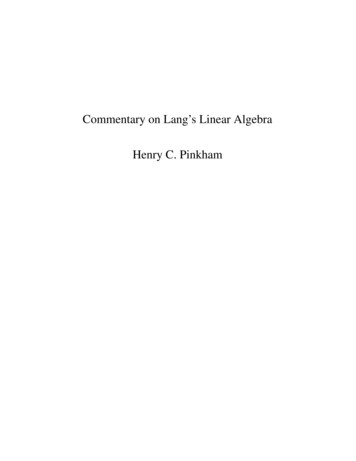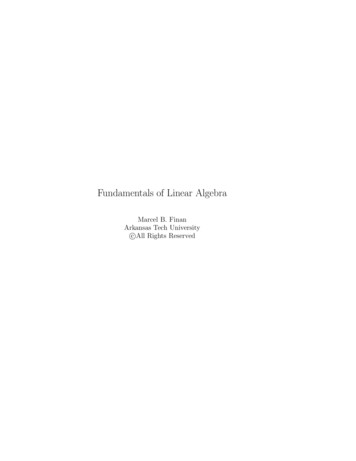
Transcription
Continue
Linear algebra and its applications solutions 4th edition pdfUser Manual: Open the PDF directly: View PDF .Page Count: 485 DownloadOpen PDF In BrowserView PDF INSTRUCTOR SOLUTIONS MANUAL INSTRUCTOR’S SOLUTIONS MANUAL THOMAS POLASKI Winthrop University JUDITH MCDONALD Washington State University L INEAR ALGEBRA AND I TS A PPLICATIONS F OURTH E DITION DavidC. Lay University of Maryland The author and publisher of this book have used their best efforts in preparing this book. These efforts include the development, research, and testing of the theories and programs to determine their effectiveness. The author and publisher make no warranty of any kind, expressed or implied, with regard to these programs or thedocumentation contained in this book. The author and publisher shall not be liable in any event for incidental or consequential damages in connection with, or arising out of, the furnishing, performance, or use of these programs. Reproduced by Pearson Addison-Wesley from electronic files supplied by the author. Copyright 2012, 2006, 1997 PearsonEducation, Inc. Publishing as Pearson Addison-Wesley, 75 Arlington Street, Boston, MA 02116. All rights reserved. No part of this publication may be reproduced, stored in a retrieval system, or transmitted, in any form or by any means, electronic, mechanical, photocopying, recording, or otherwise, without the prior written permission of the publisher. Printedin the United States of America. ISBN-13: 978-0-321-38888-9 ISBN-10: 0-321-38888-7 1 2 3 4 5 6 BB 15 14 13 12 11 Contents CHAPTER 1 Linear Equations in Linear Algebra 1 CHAPTER 2 Matrix Algebra 87 CHAPTER 3 Determinants 167 CHAPTER 4 Vector Spaces 197 CHAPTER 5Eigenvalues and Eigenvectors 273 CHAPTER 6 Orthogonality and Least Squares 357 CHAPTER 7 Symmetric Matrices and Quadratic Forms CHAPTER 8 The Geometry of Vector Spaces 405 453 iii 1.1 SOLUTIONS Notes: The key exercises are 7 (or 11 or 12), 19–22, and 25. For brevity, the symbols R1, R2, , stand for row 1 (or equation 1), row 2 (orequation 2), and so on. Additional notes are at the end of the section. 1. x1 5 x2 7 2 x1 7 x2 5 ª 1 « 2 5 7 7º 5»¼ Replace R2 by R2 (2)R1 and obtain: x1 5 x2 7 3x2 9 x1 5 x2 7 Scale R2 by 1/3: x2 3 x1 Replace R1 by R1 (–5)R2: 8 x2 3 ª1 «0 5 ª1 «0 5 ª1 «0 0 ª1 «5 2 7º 9 »¼ 3 7º 3 »¼ 1 1 8 º 3»¼ The solution is(x1, x2) (–8, 3), or simply (–8, 3). 2. 3x1 6 x2 3 5 x1 7 x2 10 ª3 «5 6 7 3 º 10 »¼ Scale R1 by 1/3 and obtain: Replace R2 by R2 (–5)R1: Scale R2 by –1/3: Replace R1 by R1 (–2)R2: x1 2 x2 1 5 x1 7 x2 10 x1 2 x2 1 3x2 15 x1 2 x2 1 x2 5 x1 9 x2 5 ª1 «0 1º 10 »¼ 7 2 3 ª1 «0 2 ª1 «0 0 1 1 1º 15»¼ 1º 5»¼ 9º 5 »¼ The solution is (x1, x2) (9, –5), or simply (9, –5). Copyright 2012 Pearson Education, Inc. Publishing as Addison-Wesley. 1 2 CHAPTER 1 Linear Equations in Linear Algebra 3. The point of intersection satisfies the system of two linear equations: x1 2 x2 4 ª1 «1 x1 x2 1 2 1 4º 1»¼ x1 2 x2 4 Replace R2 by R2 (–1)R1 andobtain: 3 x2 3 x1 2 x2 4 Scale R2 by –1/3: x2 1 2 x1 Replace R1 by R1 (–2)R2: x2 1 ª1 «0 ª1 «0 ª1 «0 2 3 4º 3»¼ 4º 1 »¼ 2 1 2º 1»¼ 0 1 The point of intersection is (x1, x2) (2, 1). 4. The point of intersection satisfies the system of two linear equations: x1 2 x2 13 3 x1 2 x2 1 ª1 «3 2 2 13º 1»¼ Replace R2 by R2 (–3)R1 and obtain: Scale R2 by –1/8: Replace R1 by R1 (–2)R2: x1 2 x2 13 8 x2 40 x1 2 x2 13 x1 x2 5 3 x2 5 ª1 «0 2 8 ª1 «0 2 ª1 «0 0 1 1 13º 40 »¼ 13º 5»¼ 3 º 5 »¼ The point of intersection is (x1, x2) (–3, –5). 5. The system is already in “triangular” form. The fourth equation is x4 –5, and the other equations donot contain the variable x4. The next two steps should be to use the variable x3 in the third equation to eliminate that variable from the first two equations. In matrix notation, that means to replace R2 by its sum with –4 times R3, and then replace R1 by its sum with 3 times R3. 6. One more step will put the system in triangular form. Replace R4 by its sum with–4 times R3, which 4 0 1º ª 1 6 «0 2 7 0 4 »» « . After that, the next step is to scale the fourth row by –1/7. produces «0 0 1 2 3» « » 0 0 7 14 ¼ 0 7. Ordinarily, the next step would be to interchange R3 and R4, to put a 1 in the third row and third column. But in this case, the third row of the augmented matrix corresponds to the equation 0 x1 0 x2 0x3 1, or simply, 0 1. A system containing this condition has no solution. Further row operations are unnecessary once an equation such as 0 1 is evident. The solution set is empty. Copyright !2012 Pearson Education, Inc. Publishing as Addison-Wesley. 1.1 Solutions 8. The standard row operations are: ª1 «0 « «0 « 0 5 4 0 1 0 0 0 3 0 1 0 2 ª1 «0 « «0 « 0 0º ª 1 0 »» «« 0 0» «0 » « 0¼ 0 5 1 0 0 0 1 0 0 0 0 0 1 5 4 0 1 0 0 0 3 0 1 0 1 0 1 0 0 0 1 0 0 0 0 0 1 0º ª 1 0»» ««0 0» «0 » « 0¼ 0 0º ª 1 0 »» «« 0 0» «0 » « 0¼ 0 5 4 0 1 0 0 0 3 0 0 0 1 0º ª 1 0 »» ««0 0 » «0 » « 0¼ 0 5 4 0 1 0 0 0 1 0 0 0 1 0º 0 »» 0» » 0¼ 0º 0»» 0» » 0¼ The solution set contains one solution: (0, 0, 0, 0). 9. Thesystem has already been reduced to triangular form. Begin by replacing R3 by R3 (3)R4: ª1 «0 « «0 « 0 1 1 0 2 0 0 0 0 1 0 3 1 5º ª 1 7 »» «« 0 2» «0 » « 4¼ 0 1 1 0 2 0 0 0 0 1 0 0 1 5º 7 »» 14 » » 4¼ Next, replace R2 by R2 (2)R3. Finally, replace R1 by R1 R2: ª1 «0 « «0 « 0 1 1 0 0 0 0 0 0 1 0 0 1 5º ª 1 21»» «« 0 14 » « 0 » « 4 ¼ 0 0 1 0 0 0 0 1 0 16 º 21»» 0 14 » » 1 4¼ 0 0 The solution set contains one solution: (16, 21, 14, 4). 10. The system has already been reduced to triangular form. Use the 1 in the fourth row to change the 3 and –2 above it to zeros. That is, replace R2 by R2 (-3)R4 and replace R1 by R1 (2)R4. For the final step, replace R1 by R1 (-3)R2. ª1 «0 « «0 « 03 1 0 0 2 3 0 0 1 0 0 1 7 º ª 1 6 »» «« 0 2» «0 » « 2 ¼ 0 3 1 0 0 0 0 0 0 1 0 0 1 11º ª 1 12 »» ««0 2» «0 » « 2 ¼ 0 0 1 0 0 0 0 0 0 1 0 0 1 47 º 12»» 2» » 2 ¼ The solution set contains one solution: (–47, 12, 2, –2). 11. First, swap R1 and R2. Then replace R3 by R3 (–2)R1. Finally, replace R3 by R3 (1)R2. ª0 «1 « « 2 1 4 7 5 3 1 4º ª 1 2»» «« 0 2 »¼ « 2 4 1 7 3 5 1 2º ª 1 4»» «« 0 2 »¼ « 0 4 1 1 3 5 5 2 º ª 1 4 »» «« 0 2 »¼ « 0 4 1 0 3 5 0 2º 4»» 2»¼ The system is inconsistent, because the last row would require that 0 –2 if there were a solution. The solution set is empty. Copyright 2012 Pearson Education, Inc. Publishing as Addison-Wesley. 3 4 CHAPTER 1 Linear Equations in Linear Algebra 12. Replace R2 by R2 (–2)R1 and replace R3 by R3 (2)R1. Finally, replace R3 by R3 (3)R2. 5 7 1 ª 1 « 2 « « 2 4 3 7 3º ª 1 2 »» ««0 1»¼ « 0 5 3 9 4 5 15 3º ª 1 4»» «« 0 7 »¼ « 0 5 3 0 4 5 0 3º 4»» 5»¼ The system is inconsistent, because the last row would require that 0 5 if there were asolution. The solution set is empty. ª1 13. «« 2 « 0 ª1 ««0 « 0 ª2 14. «« 0 « 3 ª1 ««0 « 0 3 9 5 0 2 1 0 1 0 8º ª 1 7 »» ««0 2 »¼ « 0 3 5 1 6 2 2 0 1 6 0 1 0 8º ª 1 2 »» ««0 1»¼ « 0 8º ª 1 3»» ««0 4 ¼» « 3 3 2 1 4º ª 1 3»» ««0 2 »¼ « 0 3 15 5 0 2 1 0 1 0 0 0 1 3 2 2 0 1 6 0 1 0 3 0 1 8º ª 1 9 »» ««0 2 »¼ « 0 3 5 15 0 1 28º ª 1 2 »» ««0 9»¼ « 0 0 1 0 3 5 5 8º 2 »» 5»¼ 0 1 0 3 2 5 4º 3»» 10¼» 5º 3»» . The solution is (5, 3, –1). 1»¼ 4º ª 1 3»» ««0 4¼» «0 4º ª 1 1»» ««0 2 »¼ « 0 3 2 7 0 1 6 0 1 0 0 0 1 4º ª 1 3»» «« 0 8¼» « 0 2º 1»» . The solution is (2, –1, 2). 2 »¼ 15. First, replace R3 by R3 (1)R1, then replace R4 by R4 (1)R2, and finallyreplace R4 by R4 (– 1)R3. 0 0 5º ª 1 6 0 0 5º ª 1 6 0 0 5º ª 1 6 0 0 5º ª 1 6 « 0 » « » « » « 1 4 1 0 » « 0 1 4 1 0 » «0 1 4 1 0 » « 0 1 4 1 0 »» « « 1 6 1 5 3» « 0 0 1 5 8» «0 0 1 5 8» « 0 0 1 5 8» « » « » « » « » 5 4 0 ¼ 0 1 5 4 0 ¼ 0 0 1 5 0¼ 0 0 0 0 8¼ 0 1 The system is inconsistent, because the last row would require that 0 –8 ifthere were a solution. 16. First replace R4 by R4 (3/2)R1 and replace R4 by R4 (–2/3)R2. (One could also scale R1 and R2 before adding to R4, but the arithmetic is rather easy keeping R1 and R2 unchanged.) Finally, replace R4 by R4 (–1)R3. ª 2 0 0 4 10 º ª 2 0 0 4 10 º ª 2 0 0 4 10º ª 2 0 0 4 10 º « 0 3 3 0 0 »» «« 0 3 3 0 0»» «« 0 3 3 0 0»»«« 0 3 3 0 0 »» « « 0 0 1 1» « 0 0 1 1» « 0 0 1 1» « 0 0 1 1» 4 4 4 4 « » « » « » « » 9 ¼ 1 5¼ 0 2 3 5 10¼ 0 0 1 5 10¼ 0 0 0 9 3 2 3 The system is now in triangular form and has a solution. In fact, using the argument from Example 2, one can see that the solution is unique. Copyright !2012 Pearson Education, Inc. Publishing asAddison-Wesley. 1.1 Solutions 5 17. Row reduce the augmented matrix corresponding to the given system of three equations: 3 1º ª 2 3 1º ª 2 3 1º ª2 «6 » « » « 5 0 » « 0 4 3» « 0 4 3»» « « 2 5 7 »¼ « 0 8 8»¼ « 0 0 2»¼ The third equation, 0 2, shows that the system is inconsistent, so the three lines have no point in common. 18. Rowreduce the augmented matrix corresponding to the given system of three equations: ª2 «0 « « 2 4 1 3 4 2 0 4º ª2 2»» «« 0 0¼» « 0 4 1 1 4 2 4 4º ª 2 2»» «« 0 4¼» « 0 4 1 0 4 2 6 4º 2»» 6¼» The system is consistent, and using the argument from Example 2, there is only one solution. So the three planes have only one point in common.4º h ª 1 h 4 º ª1 19. « « » » Write c for 6 – 3h. If c 0, that is, if h 2, then the system has no 3 6 8¼ 0 6 3h 4 ¼ solution, because 0 cannot equal –4. Otherwise, when h 2, the system has a solution. h 5 º ª 1 h 5 º ª1 Write c for 8 2h. If c 0, that is, if h –4, then the system 20. « « » 6 ¼ 0 8 2h 16 »¼ 2 8 has no solution, because 0cannot equal 16. Otherwise, when h –4, the system has a solution. 4 2 º ª 1 4 2 º ª 1 21. « « » » Write c for h 12 . Then the second equation cx2 0 has a solution 3 h 6 ¼ 0 h 12 0 ¼ for every value of c. So the system is consistent for all h. ª 4 hº « 3»¼ « 0 and only if h 6. ª 4 22. « 2 12 6 12 0 º h h »» The system is consistent if andonly if 3 0, that is, if 2 3 2¼ h 23. a. True. See the remarks following the box titled Elementary Row Operations. b. False. A 5 6 matrix has five rows. c. False. The description applies to a single solution. The solution set consists of all possible solutions. Only in special cases does the solution set consist of exactly one solution. Mark a statement Trueonly if the statement is always true. d. True. See the box before Example 2. 24. a. False. The definition of row equivalent requires that there exist a sequence of row operations that transforms one matrix into the other. b. True. See the box preceding the subsection titled Existence and Uniqueness Questions. c. False. The definition of equivalent systems is inthe second paragraph after equation (2). d. True. By definition, a consistent system has at least one solution. Copyright 2012 Pearson Education, Inc. Publishing as Addison-Wesley. 6 CHAPTER 1 ª 1 25. «« 0 « 2 Linear Equations in Linear Algebra 4 3 5 4 3 3 g º ª1 h »» «« 0 k ¼» «0 7 5 9 7 5 5 4 3 0 g º ª1 h »» «« 0 k 2 g ¼» « 0 7 50 g º » h » k 2 g h ¼» Let b denote the number k 2g h. Then the third equation represented by the augmented matrix above is 0 b. This equation is possible if and only if b is zero. So the original system has a solution if and only if k 2g h 0. 26. Row reduce the augmented matrix for the given system: ª2 «c 4 d f º ª1 g »¼ « c 2 d f / 2 º ª1 g»¼ « 0 2 º g c ( f / 2) »¼ f /2 d 2c This shows that d – 2c must be nonzero, since f and g are arbitary. Otherwise, for some choices of f and g the second row would correspond to an equation of the form 0 b, where b is nonzero. Thus d 2c. 27. Row reduce the augmented matrix for the given system. Scale the first row by 1/a, which is possible since a isnonzero. Then replace R2 by R2 (–c)R1. ªa « c b d f º ª1 g ¼» « c f / a º ª1 g ¼» « 0 b/a d º g c( f / a ) ¼» b/a f /a d c(b / a ) The quantity d – c(b/a) must be nonzero, in order for the system to be consistent when the quantity g – c( f /a) is nonzero (which can certainly happen). The condition that d – c(b/a) 0 can also be written as ad – bc 0, orad bc. 28. A basic principle of this section is that row operations do not affect the solution set of a linear system. Begin with a simple augmented matrix for which the solution is obviously (3, –2, –1), and then perform any elementary row operations to produce other augmented matrices. Here are three examples. The fact that they are all row equivalent provesthat they all have the solution set (3, –2, – 1). ª1 « «0 « 0 0 1 0 0 0 1 3º ª 1 2»» «« 2 1»¼ « 0 0 1 0 0 0 1 3º ª 1 4»» «« 2 1»¼ « 2 0 1 0 0 0 1 3º 4»» 5»¼ 29. Swap R1 and R3; swap R1 and R3. 30. Multiply R3 by –1/5; multiply R3 by –5. 31. Replace R3 by R3 (–4)R1; replace R3 by R3 (4)R1. 32. Replace R3 by R3 (–4)R2; replace R3 by R3 (4)R2. 33. The first equation was given. The others are: T2 (T1 20 40 T3 )/4, or 4T2 T1 T3 60 T3 (T4 T2 40 30)/4, or 4T3 T4 T2 70 T4 (10 T1 T3 30)/4, or 4T4 T1 T3 40 Copyright !2012 Pearson Education, Inc. Publishing as Addison-Wesley. 1.1 Solutions 7 Rearranging, 4T1 T2 T1 4T2 T2 T1 T4 30 T3 4T3 T4 60 70 4T4 40 T3 34. Begin by interchanging R1 and R4, then create zeros in the first column: ª 4 « 1 « « 0 « 1 1 0 1 4 1 1 4 0 1 0 1 4 30 º ª 1 60 » « 1 » « 70 » « 0 » « 40 ¼ 4 0 1 4 4 1 1 4 0 1 1 0 1 40 º ª 1 60 » « 0 » « 70 » « 0 » « 30 ¼ 0 0 1 4 1 0 4 1 4 40 º 20 » 4 » 1 70 » » 15 190 ¼ 4 Scale R1by –1 and R2 by 1/4, create zeros in the second column, and replace R4 by R4 R3: ª1 «0 « «0 « 0 0 1 4 1 1 0 4 1 1 1 4 15 40 º ª 1 5» « 0 » « 70 » « 0 » « 190 ¼ 0 0 1 4 1 0 0 4 1 2 0 4 14 40 º ª 1 5» « 0 » « 75» « 0 » « 195¼ 0 0 1 4 1 0 0 4 1 2 0 0 12 40 º 5» » 75» » 270 ¼ Scale R4 by 1/12, use R4 to create zeros in column 4,and then scale R3 by 1/4: ª1 «0 « «0 « 0 0 1 4 1 0 0 4 1 2 0 0 1 40 º ª 1 5» «0 » « 75» «0 » « 22.5¼ 0 0 1 0 1 0 0 4 0 0 0 0 1 50 º ª 1 27.5» « 0 » « 120 » «0 » « 22.5¼ 0 0 1 0 1 0 0 1 0 0 0 0 1 50 º 27.5» » 30 » » 22.5¼ The last step is to replace R1 by R1 (–1)R3: ª1 «0 « «0 « 0 0 0 0 1 0 0 1 0 0 0 0 1 20.0 º 27.5» » . The solution is (20, 27.5, 30,22.5). 30.0 » » 22.5¼ Notes: The Study Guide includes a “Mathematical Note” about statements, “If , then .” This early in the course, students typically use single row operations to reduce a matrix. As a result, even the small grid for Exercise 34 leads to about 80 multiplications or additions (not counting operations with zero). This exercise should givestudents an appreciation for matrix programs such as MATLAB. Exercise 14 in Section 1.10 returns to this problem and states the solution in case students have not already solved the system of equations. Exercise 31 in Section 2.5 uses this same type of problem in connection with an LU factorization. For instructors who wish to use technology in thecourse, the Study Guide provides boxed MATLAB notes at the ends of many sections. Parallel notes for Maple, Mathematica, and the TI-83 /84 /89 calculators appear in separate appendices at the end of the Study Guide. The MATLAB box for Section 1.1 describes how to access the data that is available for all numerical exercises in the text. This featurehas the ability to save students time if they regularly have their matrix program at hand when studying linear algebra. The MATLAB box also explains the basic commands replace, swap, and scale. These commands are included in the text data sets, available from the text web site, www.pearsonhighered.com/lay. Copyright 2012 Pearson Education, Inc.Publishing as Addison-Wesley. 8 CHAPTER 1 1.2 Linear Equations in Linear Algebra SOLUTIONS Notes: The key exercises are 1–20 and 23–28. (Students should work at least four or five from Exercises 7–14, in preparation for Section 1.5.) 1. Reduced echelon form: a and b. Echelon form: d. Not echelon: c. 2. Reduced echelon form: a. Echelon form: band d. Not echelon: c. ª1 3. «« 2 « 3 2 4 6 4 6 9 ª1 ««0 « 0 ª1 4. «« 2 « 4 2 4 5 8º ª 1 8»» ««0 12 »¼ « 0 ª1 ««0 « 0 8º ª 1 4 »» ««0 0 »¼ « 0 2 0 0 5 º ª1 4 »» ««0 2 »¼ « 0 2 0 3 4 3 12 2 1 0 4 4 1 5º ª 1 6»» «« 0 2 »¼ « 0 „º 0 »¼ ª„ 5. « 0 * º ª„ , „»¼ « 0 *º ª0 , 0 »¼ « 0 ª1 7. « 3 3 9 7º ª 1 6 »¼ « 0 4 7 4 2 3 4 1 0 2 0 0 4 5 4 2 0 03 0 2 1 0 8º ª 1 8»» ««0 12 »¼ « 0 0 1 0 2 0 0 8º 4»» . Pivot cols 1 and 3. 0»¼ 5 º ª1 6 »» ««0 18»¼ « 0 4 0 1 2 3 0 5º ª 1 2 »» ««0 2 »¼ « 0 7º ª 1 15»¼ « 0 Corresponding system of equations: x1 3 0 * º ª„ „»» , «« 0 0 ¼» « 0 3 x2 x3 2 4 6 *º ª0 0 »» , ««0 0¼» «0 7º ª 1 3»¼ « 0 8º 8»» 12 »¼ 4 6 9 1º Pivot cols 2 »» . 1, 2, and 3 2»¼ 0 0 1 4 1 ª1 «2 « « 3 5 º ª1 18»» «« 0 6 »¼ « 0 4 12 3 0 1 0 ª„ 6. «« 0 « 0 4 5 8º 4»» 12»¼ 4 1 3 2 1 0 4 4 3 ª1 «2 « « 4 2 4 5 5º 6»» 6»¼ 4 5 4 5º 4 »» 2 »¼ „º 0 »» 0 »¼ 3 0 0 1 5 º 3»¼ 5 3 The basic variables (corresponding to the pivot positions) are x1 and x3. The remaining variable x2 is free. Solve for the basic variables interms of the free variable. The general solution is x1 5 3 x2 x2 is free x 3 3 Note: Exercise 7 is paired with Exercise 10. Copyright !2012 Pearson Education, Inc. Publishing as Addison-Wesley. 1.2 8. ª 1 « 3 3 5 º ª 1 3 0 5 º ª 1 2 0 6 »¼ « 0 7 0 1 0 3»¼ « 0 x 4 Corresponding system of equations: 1 x2 3 0 5 º ª 1 9 »¼ « 0 3 0 0 0 1 0 Solutions 9 4º 3»¼ The basic variables (corresponding to the pivot positions) are x1 and x2. The remaining variable x3 is free. Solve for the basic variables in terms of the free variable. In this particular problem, the basic variables do not depend on the value of the free variable. x1 4 General solution: x2 3 x is free 3 Note: Acommon error in Exercise 8 is to assume that x3 is zero. To avoid this, identify the basic variables first. Any remaining variables are free. (This type of computation will arise in Chapter 5.) ª0 9. « 1 1 2 3 4 3º ª 1 6 »¼ « 0 Corresponding system: 3 4 1 2 x1 x2 6 º ª 1 3»¼ « 0 2 x3 3 2 x3 3 0 2 1 2 3º 3»¼ x1 3 2 x3 Basic variables:x1, x2; free variable: x3. General solution: x2 3 2 x3 x is free 3 ª 1 10. « 2 2 1 4 5 4º ª 1 6 »¼ « 0 Corresponding system: x1 2 1 0 7 4º ª 1 14 »¼ « 0 2 x2 2 x3 2 0 0 1 2º 2 »¼ 2 x1 2 2 x2 Basic variables: x1, x3; free variable: x2. General solution: x2 is free x 2 3 ª3 11. ««9 « 6 2 6 4 4 12 8 2 0 0 0º ª 3 0»» ««0 0 »¼ « 0 x1 Corresponding system: 4 0 0 0º ª 1 0»» «« 0 0»¼ « 0 2 x2 3 4 x3 3 0 0 2 3 0 0 43 0 0 0º 0»» 0»¼ 0 0 0 Copyright 2012 Pearson Education, Inc. Publishing as Addison-Wesley. 10 CHAPTER 1 Linear Equations in Linear Algebra 2 4 x1 3 x2 3 x3 Basic variable: x1; free variables x2, x3. General solution: x2 isfree x is free 3 12. Since the bottom row of the matrix is equivalent to the equation 0 1, the system has no solutions. ª1 «0 13. « «0 « 0 3 0 1 0 1 0 0 0 0 1 4 9 0 0 0 0 2 º ª 1 1» «0 » « 4» «0 » « 0¼ 0 3 0 0 9 1 0 0 0 0 1 4 9 0 0 0 0 x1 x2 Corresponding system: x4 2º ª 1 1» « 0 » « 4» «0 » « 0¼ 0 3 x5 5 4 x5 0 0 0 3 1 0 0 0 0 1 4 9 00 0 0 5º 1» » 4» » 0¼ 1 9 x5 4 0 0 x1 5 3x5 x 1 4x 5 2 Basic variables: x1, x2, x4; free variables: x3, x5. General solution: x3 is free x 4 9x 5 4 ̄ x5 is free Note: The Study Guide discusses the common mistake x3 0. ª1 «0 14. « «0 « 0 0 1 5 4 0 1 8 0 0 0 0 0 0 0 1 0 3º ª 1 6 »» ««0 0 » «0 » « 0 ¼ 0 5 4 0 1 0 0 0 0 0 0 0 0 10 5 x3 x1 Corresponding system: 0 1 x2 4 x3 3º 6 »» 0» » 0¼ 3 x4 6 x5 0 0 0 x1 3 5 x3 x 6 4x x 3 4 2 Basic variables: x1, x2, x5; free variables: x3, x4. General solution: x3 is free x is free 4 ̄ x5 0 15. a. The system is consistent. There are many solutions because x3 is a free variable. b. The system is consistent. There aremany solutions because x1 is a free variable. 16. a. The system is inconsistent. (The rightmost column of the augmented matrix is a pivot column). Copyright !2012 Pearson Education, Inc. Publishing as Addison-Wesley. 1.2 Solutions 11 b. The system is consistent. There are many solutions because x2 is a free variable. 4 º ª 1 1 4 º ª 1 1 17. « Thesystem has a solution for all values of h since the augmented « » 3 h ¼ 0 1 h 8»¼ 2 column cannot be a pivot column. 1º ª 1 3 1º ª 1 3 18. « If 3h 6 is zero, that is, if h –2, then the system has a « » 6 2 ¼ 0 3h 6 h 2 »¼ h solution, because 0 equals 0. When h 2, the system has a solution since the augmented column cannot be apivot column. Thus the system has a solution for all values of h. 2 º h ª 1 h 2 º ª1 19. « « » » 4 8 k ¼ 0 8 4 h k 8¼ a. When h 2 and k 8, the augmented column is a pivot column, and the system is inconsistent. b. When h 2, the system is consistent and has a unique solution. There are no free variables. c. When h 2 and k 8, the system isconsistent and has many solutions. 3 1 º ª 1 3 1º ª1 20. « « » h k ¼ 0 h 6 k 2 »¼ 2 a. When h –6 and k 2, the system is inconsistent, because the augmented column is a pivot column. b. When h 6, the system is consistent and has a unique solution. There are no free variables. c. When h –6 and k 2, the system is consistent and has manysolutions. 21. a. b. c. d. e. False. See Theorem 1. False. See the second paragraph of the section. True. Basic variables are defined after equation (4). True. This statement is at the beginning of Parametric Descriptions of Solution Sets. False. The row shown corresponds to the equation 5x4 0, which does not by itself lead to a contradiction. So the systemmight be consistent or it might be inconsistent. 22. a. True. See Theorem 1. b. False. See Theorem 2. c. False. See the beginning of the subsection Pivot Positions. The pivot positions in a matrix are determined completely by the positions of the leading entries in the nonzero rows of any echelon form obtained from the matrix. d. True. See the paragraph justbefore Example 4. e. False. The existence of at least one solution is not related to the presence or absence of free variables. If the system is inconsistent, the solution set is empty. See the solution of Practice Problem 2. Copyright 2012 Pearson Education, Inc. Publishing as Addison-Wesley. 12 CHAPTER 1 Linear Equations in Linear Algebra 23. Sincethere are four pivots (one in each row), the augmented matrix must reduce to the form ª1 «0 « «0 « 0 0 1 0 0 0 0 0 0 1 0 0 1 x1 aº » b» and so c» » d¼ x2 x3 x4 a b c d No matter what the values of a, b, c, and d, the solution exists and is unique. 24. The system is consistent because there is not a pivot in column 5, which means that there is not a rowof the form [0 0 0 0 1]. Since the matrix is the augmented matrix for a system, Theorem 2 shows that the system has a solution. 25. If the coefficient matrix has a pivot position in every row, then there is a pivot position in the bottom row, and there is no room for a pivot in the augmented column. So, the system is consistent, by Theorem 2. 26. Since thecoefficient matrix has three pivot columns, there is a pivot in each row of the coefficient matrix. Thus the augmented matrix will not have a row of the form [0 0 0 0 0 1], and the system is consistent. 27. “If a linear system is consistent, then the solution is unique if and only if every column in the coefficient matrix is a pivot column; otherwise there are infinitelymany solutions. ” This statement is true because the free variables correspond to nonpivot columns of the coefficient matrix. The columns are all pivot columns if and only if there are no free variables. And there are no free variables if and only if the solution is unique, by Theorem 2. 28. Every column in the augmented matrix except the rightmost column is apivot column, and the rightmost column is not a pivot column. 29. An underdetermined system always has more variables than equations. There cannot be more basic variables than there are equations, so there must be at least one free variable. Such a variable may be assigned infinitely many different values. If the system is consistent, each different valueof a free variable will produce a different solution, and the system will not have a unique solution. If the system is inconsistent, it will not have any solution. 30. Example: x1 2 x1 x2 2 x2 x3 2 x3 4 5 31. Yes, a system of linear equations with more equations than unknowns can be consistent. x1 x2 2 Example (in which x1 x2 1): x1 x2 0 3x1 2 x2 5 32. According to the numerical note in Section 1.2, when n 20 the reduction to echelon form takes about 2(20)3/3 5,333 flops, while further reduction to reduced echelon form needs at most (20)2 400 flops. Of the total flops, the “backward phase” is about 400/5733 .07 or about 7%. When n 200, the estimates are 2(200)3/3 5,333,333 flopsfor the reduction to echelon form and (200)2 40,000 flops for the backward phase. The fraction associated with the backward phase is about (4 104) /(5.3 106) .007, or about .7%. Copyright !2012 Pearson Education, Inc. Publishing as Addison-Wesley. 1.2 Solutions 13 33. For a quadratic polynomial p(t) a0 a1t a2t2 to exactly fit the data (1, 6),(2, 15), and (3, 28), the coefficients a0, a1, a2 must satisfy the systems of equations given in the text. Row reduce the augmented matrix: ª1 «1 « « 1 1 2 3 ª1 ««0 «0 6º ª 1 15»» ««0 28»¼ « 0 1 4 9 1 1 0 0 0 1 1 1 2 4º ª 1 3»» ««0 2 ¼» «0 6º ª 1 9»» ««0 22»¼ « 0 1 3 8 0 1 0 1 1 0 1 3 2 6º ª 1 9»» «« 0 4»¼ « 0 1 1 0 1 3 1 6º 9»» 2»¼ 1º 3»» 2»¼ 0 0 1 The polynomial is p(t) 1 3t 2t2. 34. [M] The system of equations to be solved is: a0 a1 0 a2 02 a3 03 a4 0 4 a5 05 a0 a1 2 a2 22 a3 23 a4 2 4 a5 25 2.90 2 3 a3 4 a4 4 4 a5 4 5 14.8 a3 63 a4 6 4 a5 65 39.6 3 4 5 74.3 a0 a1 4 a2 4 a0 a1 6 a2 62 2 a0 a0 a1 8 a2 8 a1 10 a2 10 2 a3 8 a3 10 3 a4 8 a4 10 4 a5 8 5 a5 10 0 119 The unknowns are a0, a1, , a5. Use technology to compute the reduced echelon of the augmented matrix: ª1 0 «1 2 « «1 4 « «1 6 «1 8 « «1 10 ª1 «0 « «0 « «0 «0 « « 0 0 4 0 8 0 16 0 32 16 64 256 1024 36 64 216 512 1296 4096 7776 32768 102 103 104 105 00 0 0 0 2 4 8 16 32 0 0 8 0 48 48 224 576 960 4800 0 0 192 2688 26880 0 0 480 7680 90240 0º ª 1 2.9 » « 0 » « 14.8» « 0 » « 39.6 » « 0 74.3» « 0 » « 119 ¼» « 0 0º ª 1 2.9 » « 0 » « 9» «0 » « 3.9 » « 0 8.7 » « 0 » « 14.5»¼ « 0 0 2 0 4 0 8 0 16 0 32 0 8 48 224 960 0 0 0 24 48 80 192 480 960 1248 4032 9920 7680 32640 99840 0 0 0 0 0 2 4 8 16 32 0 0 80 48 48 224 576 960 4800 0 0 0 384 7680 0 0 0 1920 42240 Copyright 2012 Pearson Education, Inc. Publishing as Addison-Wesley. 0º 2.9 » » 9» » 30.9 » 62.7 » » 104.5»¼ 0º 2.9 » » 9» » 3.9 » 6.9 » » 24.5¼» 14 CHAPTER 1 ª1 «0 « «0 « «0 «0 « « 0 Linear Equations in Linear Algebra 0 0 0 0 0 2 4 8 16 32 0 0 8 0 48 48 224 576 960 4800 0 0 0 3847680 0 0 0 0 3840 ª1 «0 « «0 « «0 «0 « « 0 0º ª 1 2.9 » « 0 » « 9 » «0 » « 3.9 » « 0 6.9 » « 0 » « 10 ¼» « 0 0 2 0 4 0 8 0 16 0 0 0 8 48 224 0 0 0 0 0 48 0 576 384 0 0 0 0 0 0 1 0 0 0 0 0 2 4 8 16 32 0 0 8 0 48 48 224 576 960 4800 0 0 0 384 7680 0 0 0 0 1 0º ª1 » «0 2.8167 » « «0 6.5000 » » " « 8.6000 » «0 «0 26.900 » » « .002604 ¼» «0 0º 2.9 » »9» » 3.9 » 6.9 » » .0026 ¼» 0 1 0 0 0 0 0 0 0 0 0 1 0 0 0 0 0 0 0 1 0 0 1 0 0 0 0 0 0 1 0º 1.7125»» 1.1948» » .6615» .0701» » .0026 ¼» Thus p(t) 1.7125t – 1.1948t2 .6615t3 – .0701t4 .0026t5, and p(7.5) 64.6 hundred lb. Notes: In Exercise 34, if the coefficients are retained to higher accuracy than shown here, then p(7.5) 64.8. If a polynomial oflower degree is used, the resulting system of equations is overdetermined. The augmented matrix for such a system is the same as the one used to find p, except that at least column 6 is missing. When the augmented matrix is row reduced, the sixth row of the augmented matrix will be entirely zero except for a nonzero entry in the augmented column,indicating that no solution exists. Exercise 34 requires 25 row operations. It should give students an appreciation for higher-level commands such as gauss and bgauss, discussed in Section 1.4 of the Study Guide. The command ref (reduced echelon form) is available, but I recommend postponing that command until Chapter 2. The Study Guide includes a“Mathematical Note” about the phrase, “If and only if,” used in Theorem 2. 1.3 SOLUTIONS Notes: The key exercises are 11–16, 19–22, 25, and 26. A discussion of Exercise 25 will help students understand the notation [a1 a2 a3], {a1, a2, a3}, and Span{a1, a2, a3}. ª 1º ª 3º ª 1 ( 3) º ª 4 º 1. u v « » « » « » « ». 2 ¼ 1¼ 2 ( 1) ¼ 1¼Using the definitions carefully, ª 1º ª 3º ª 1º ª ( 2)( 3) º ª 1 6 º ª 5º u 2 v « » ( 2) « » « » « » « » « » , or, more quickly, 2¼ 1¼ 2 ¼ ( 2)( 1) ¼ 2 2 ¼ 4 ¼ ª 1º ª 3º ª 1 6 º ª 5 º u 2v « » 2 « » « » « » . The intermediate step is often not written. 2¼ 1¼ 2 2 ¼ 4 ¼ Copyright !2012 Pearson Education,Inc. Publishing as Addison-Wesley. 1.3 Solutions 15 ª 3º ª 2 º ª 3 2 º ª 5 º 2. u v « » « » « » « ». 2 ¼ 1¼ 2 1 ¼ 1¼ Using the definitions carefully, ª 3º ª 2 º ª 3º ª ( 2)(2) º ª 3 4 º ª 1º u 2 v « » ( 2) « » « » « » « » « » , or, more quickly, 2¼ 1¼ 2 ¼ ( 2)( 1) ¼ 2 2
Linear algebra and its applications solutions 4th edition pdf User Manual: Open the PDF directly: View PDF .Page Count: 485 DownloadOpen PDF In BrowserView PDF INSTRUCTOR SOLUTIONS MANUAL INSTRUCTOR'S SOLUTIONS MANUAL THOMAS POLASKI Winthrop University JUDITH MCDONALD Washington State University L INEAR ALGEBRA AND I TS A PPLICATIONS F OURTH .
